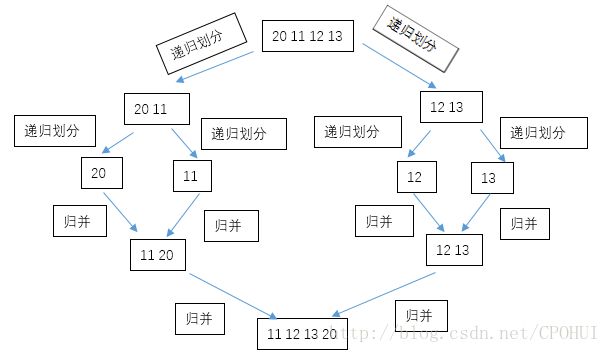数据结构&算法学习笔记: 归并排序
归并排序:
思路:每一次尽量把元素分成尽量相等的两半[x, m), [m, y)。两半的元素分别排序(递归求解),再把两个有序表合并成一个。(x 为排列元素起始的下标, y 为排列元素终止的下标 + 1,m 为 x + (y - x )/ 2 )
递归出口: 当且序列元素的长度为1时,递归结束。
合并的过程: 每次把两个序列的最小元素加以比较,把最小元素加入新表。只要一个序列非空就要继续合并 ( while( p < m || q < y ) )。因为其中一个序列为空时,因此不能直接比较A[p] 或 A[q].
- 如果第二个序列为空(q >= y),第一个序列肯定非空,复制A[p](第一个序列)
- 否则当且第二个序列非空,第一个序列也非空且A[p] <= A[q]时,复制A[p].
void merge_sort(int* A, int x, int y, int* T)
{/*A是原数组,x 为排列元素起始的下标,y为排列元素终止的下标+1
T是辅助数组*/
if(y - x > 1) //递归出口
{
int m = x + (y - x)/2;
int p = x, q = m, i = x;
merge_sort(A, x, m, T);//递归求解左半序列
merge_sort(A, m, y, T);//递归求解右半序列
while(p < m || q < y)
{//只要一个序列非空就要继续合并
if(q >= y || p < m && A[p] <= A[q])
T[i++] = A[p++];
else
T[i++] = A[q++];
}
for(i = x; i < y; i++)A[i] = T[i];//从辅助空间复制回数组A
}
}应用:求逆序对数等等。
由于归并操作是从小到大进行的,当右边的A[q]复制到T中, 左边没来得及复制到临时数组T中的就是左边所有比A[q]大的数。值得注意的是对于划分的数列,左边划分的数列的排列顺序相对于右边的数列所产生的逆序对无关。如(20,12) 和(13,19)与 (12,20)和(13,19)左边相对于右边的逆序对都为2.((20,13),(20,19)),所以归并过程中的逆序对和分块差不多。在代码上唯一修改else T[i++] = A[q++];改成else {T[i++] = A[q++]; cnt += m - p;}//左边所剩的元素在[p,m)中元素个数为m - p
题目:HDU 1394 (传送门)Minimum Inversion Number
Time Limit: 2000/1000 MS (Java/Others)
Memory Limit: 65536/32768 K (Java/Others)
Problem Description
The inversion number of a given number sequence a1, a2, …, an is the number of pairs (ai, aj) that satisfy i < j and ai > aj.
For a given sequence of numbers a1, a2, …, an, if we move the first m >= 0 numbers to the end of the seqence, we will obtain another sequence. There are totally n such sequences as the following:
a1, a2, …, an-1, an (where m = 0 - the initial seqence)
a2, a3, …, an, a1 (where m = 1)
a3, a4, …, an, a1, a2 (where m = 2)
…
an, a1, a2, …, an-1 (where m = n-1)
You are asked to write a program to find the minimum inversion number out of the above sequences.
Input
The input consists of a number of test cases. Each case consists of two lines: the first line contains a positive integer n (n <= 5000); the next line contains a permutation of the n integers from 0 to n-1.
Output
For each case, output the minimum inversion number on a single line.
Sample Input
10
1 3 6 9 0 8 5 7 4 2
Sample Output
16
思路:对于这道题目,先用归并排序对原序列进行求逆序对。然后在每次产生新数列的过程中,减去因为这个新数列而减少的逆序对数,加上因为这个新数列而增加的逆序对数( 换句话说就是减去比序列首元素小的数的数目, 加上比比序列首元素大的数的数目。如(2,3,0,1)的逆序对数为4.那么(3,0,1,2)逆序对为4 - 2 + (4 - 2 - 1) = 3.)
#include